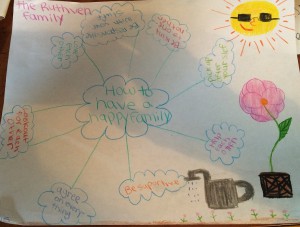
I recently had a crazy idea to take my kids through a strategic planning process. It was sparked by one of those times when you feel misaligned as a family unit, and you’re acutely aware that your vision and desired experience has fallen out of step with daily realities.
I believed we each held a similar view of what we’d like our family to be like, and that what was lacking was everyone (obviously I mean them!) fully understanding their role and what is required to support each other and achieve our vision.
I summoned a sit-down with my “peeps” – Benjamin, 12; Jaxson 11; Olivia 10 – to layout my observation and suggested proposal. Through the conversation I let them know that facilitating discussions like this was part of what I do on a regular basis for clients as part of my career (which they’re still largely unclear about). Oddly, I felt the need to sell them on my expertise and ability. Tough crowd.
Quickly, their corporate personalities emerged and an aha moment happened for me – the exercise I had started with my kids perfectly paralleled actual team processes I had executed for various clients. In fact, because this is all so new to them and they’re pretty unencumbered as far as the corporate team game goes, it’s an amplified process; ripe with transferable learning moments and insights. I needed to document.
After my initial introduction, Olivia’s hand went up and she immediately dove into the details of what action items would help us achieve the family experience we wanted. Jaxson expressed concern of what happens if one of the others didn’t comply or do their part – how do we protect against failure? And Benjamin, sat quietly, thinking. When I pressed him to share he offered that he thought this was a good idea, but that he would wait to see what it looked like before he really could say for sure how he felt.
How many of you have these personalities on your teams (direct team, leadership or otherwise)? Being aware of the personalities you’ll be moving through this process with, allows you to appeal to and leverage their tendencies and/or mitigate the affect on others.
I know I need to provide Olivia with practical, detailed examples and scenarios as we discuss concepts and ideas. I will need to consciously move her forward to avoid her becoming stuck and focusing on details or thinking the detail means we’re done (& thereby avoiding the all important journey). Jaxson brings to the table the fairness and equity cards by requiring assurance that both his brother and sister understand that they will be equally required to participate and take equal ownership for any plans that come out of this process. Benjamin needs to understand the complete process, see the benefits and ensure logic is appropriately accounted for.
And most importantly, I need to realize that I need to experience the process and be open to hearing that I might not be fully aligned to their vision (could be I don’t engage in sports enough). Maybe our family vision looks slightly different than I thought. I saw myself falling into the leadership trap of viewing the problem & required work to be residing only at the “staff” level (don’t we all wish our kids could be staff – not the other way around!!). I know a shared vision doesn’t happen top-down, but here I was (although to be clear, I will take the role of a strong leader who sets the tone for culture and required outcomes, etc.).
We had successfully agreed that there’s a problem and room for improvement, and embraced the steps and roles/responsibilities we’re going to follow to get there together. Our mandate is set.
Next, we’ll take our first step forward by focusing on vision development and alignment. We had a brief discussion over the question that should be posed (& posted in a high traffic area alongside sticky notes and about a thousand pens) in order to facilitate the articulation of values. I’ve been testing out a few options and will talk about that next time.
Knowing your audience, their take on the process and what you need to keep in mind (and in play) during the work is a fundamental starting place. We’ve started our journey and we’ll see where this crazy idea takes us and what we learn – about ourselves and the art of the strategic planning process – along the way.
Within an hour of concluding our discussion, Olivia presented me with her “answer.”
Next time: The Question
So here we are. It’s anything but business as usual. A sense of surrealism is in the air. Most organizations have rapidly morphed into new ways of conducting their daily business and as things have started to settle, are now able to see the trees in the forest (I meant to say it that way).
Leaders are realizing that operational evolution is upon them. Change processes that have historically been avoided or taken years to seed and accomplish are now required to happen in mere weeks or months, without much, if any, organizational socialization.
As we adjust into this phase of new normal and anticipate the next new normal, opportunities for organizations abound. Why? Because nothing brings out the best (or worst) in people than a shared challenge and a scary time. Think of your experiences personally, that of the province and country: everyone coming together, expressing themselves, acting as one team, caretaking of others and articulating a shared sense of pride. Those experiences should be no different in our organizations.
Here are a few things to contemplate:
Assess Leadership: Real leaders are shining, inspirational and taking charge; those not up for the task are skimming the surface, doing the minimum and engaging reactively and passively. In today’s context, the differences are glaringly obvious, whereas previously they could be camouflaged by structure or high task performance. Functionally, distinct leadership performance criteria (broad leadership qualities vs. tasks) can act as your guide and go-forward mechanism. No organization can afford to have weak leadership at any level these days.
Develop Team: If you have been concerned about team alignment, culture and performance, now is the ideal time to focus on it. Many employees are feeling untethered and worried about their future, even those still able to work. Reaffirm (or (re-)create) your organizational vision, values and guiding principles and integrate them into everyone’s daily work while demonstrating organizational caring and support. Collaborate with teams to uncover innovations, new ways of conducting daily business and resolve challenges and problems through dialogue. This is fertile ground and how your organization engages will be remembered. Don’t forget to include furloughed employees.
Innovate: Hard edges create great breeding grounds for innovation. How an organization has worked is over. How they will or could work is emerging. Tap your teams, system and relationships to surface and operationalize innovation. Integrate this work with team development activities.
Gain Strategic Alignment: Operational changes – whether enduring or temporary – need to align to an organization’s foundational elements. In these circumstances, that foundation may need to evolve. Analyze the success and/or potential of these changes (KPI, ROI, etc.) against both your current strategic goals and objectives and potential future ones. Stay true to your guiding principles and evolve your values (if needed), determine what needs to adjust (if anything) in your strategic plan and associated policies, procedures and processes. Assess your relationships and partnerships reflective of behaviour and value during this crazy time.
Think Strategically: Think about initiatives or change that you have been avoiding or putting off that would get you closer to your goals faster; this time of upheaval may be the right environment to rethink, reinvent and rebuild. I have been likening these fast-tracked changes to “trojan horses” but in a good way. Undertake a future thinking and planning process (i.e., scenario planning) to uncover potential opportunities while positioning to leverage them.
Communicate: Active communications wins the day here. Passive communications are more obviously inauthentic and irrelevant than ever.
- Passive includes inconsistent one-size fits all email blasts, broad requests to post to twitter/Instagram, open invitations to participate, lack of personalization and authenticity, no real news.
- Active includes transparency, knowledge sharing, targeted and relevant consistent engagement, distinct activities in relevant groups, personalization including referencing and profiling team members.
Pursuing any of these opportunities may feel like performing open heart surgery while running a marathon; committing to any or all will help position you and your organization for success now and in the unfolding new normal(s).
Unprecedented times: Unprecedented opportunity.
big think communications is here to help. Because remarkable doesn’t just happen.

